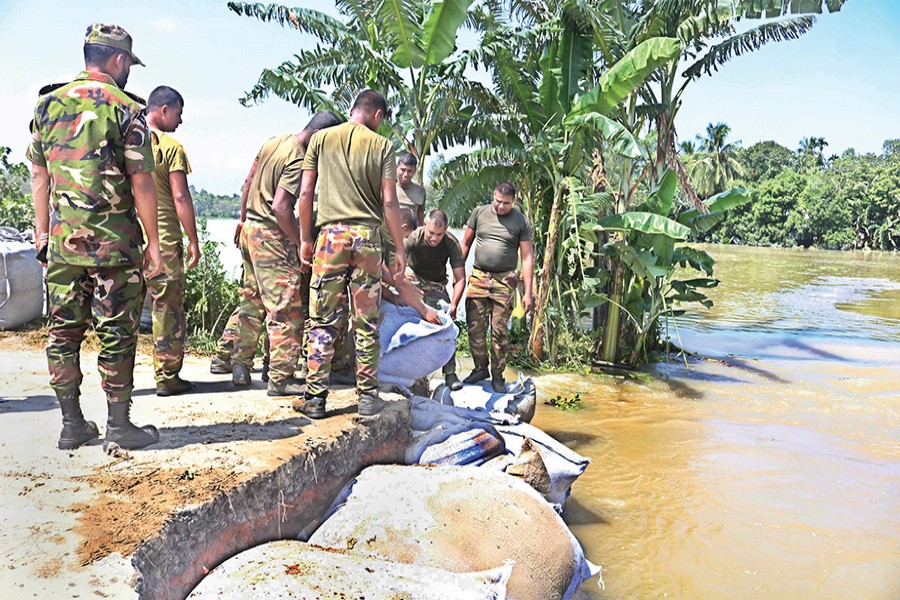 Army personnel busy on Saturday protecting Tangail's Tarakandi-Bhuapur Road embankment at risk of caving in under the impact of rushing floodwater — Focus Bangla
Army personnel busy on Saturday protecting Tangail's Tarakandi-Bhuapur Road embankment at risk of caving in under the impact of rushing floodwater — Focus Bangla Thousands of people were still left marooned in flood-affected districts in the country on on Saturday, though water levels in many rivers continued to recede triggering land erosion and breach of dams.
The flood situation was improving in the northern region but deteriorating in the central region, triggering fear of flooding even in the capital.
More than 3.0 million people in Kurigram, Gaibandha, Sirajganj, Naogaon, Jamalpur, Tangail, Bogura, Faridpur, Shariatpur, Munshiganj and other districts were facing a shortage of food and drinkable water amid inadequate supply of relief materials, sources said.
Rescue efforts were also insufficient at places causing immense sufferings to the people living in waterlogged areas, they said.
After the Padma, Jamuna and Brahmaputra rivers, the water level in the Meghna also rose at Chandpur, indicating severe flooding in the event of rain continuing for the next seven weeks, said officials.
However, 14 rivers at 21 points in 13 districts were flowing above the danger marks on Saturday, according to the state-run Flood Forecasting and Warning Centre (FFWC).
The FFWC in its evening update said water levels in Jamuna, Padma and other rivers adjacent to the capital would be rising. But other rivers might recede.
It said the flood situation in Manikganj, Rajbari, Faridpur, Shariatpur and Munshiganj districts might deteriorate.
Flooding in Rangpur and Rajshahi divisions (in terms of water level) might improve in the next few hours, it said.
It also showed that water levels in 39 rivers increased while 53 rivers receded on Saturday.
But many places in the flood-affected districts were inundated on Saturday amid breach of dams.
Our Naogaon correspondent Rabiul Islam Tushar adds: Around 0.2 million people in Manda and Raninagar upazilas of the district were marooned after embankments at several points along the Atrai and Chhoto Jamuna collapsed.
However, the flood situation in the upazilas slightly improved on Saturday.
The river Atrai was flowing 30cm above the danger level, down from 100cm, when the dams were breached, WDB sources said.
They said the dam collapsed on late Monday and Tuesday sending flash floods through 22 villages in Manda.
Later on Friday, a big portion of the flood control embankment along the Chhoto Jamuna collapsed, washing away three more villages in Ranunagar upazila.
Executive engineer of Naogaon Water Development Board (WDB) Sudhangshu Kumar said, "As the water level has started to reduce, we will start repairing the dams soon to prevent further flood-induced loss."
On the other hand, flood-affected people in the two upazilas alleged that they had not been brought under any relief programme yet.
Only 800 people came under the government's relief net who got 10 kg of rice, 2 kg of flattened rice (chira), 2 kg lentil, 1.0 kg salt, 1.0 kg sugar and 1 litre of soybean oil.
AKM Mannan, District Relief and Rehabilitation Officer, said only the flood-hit marginalised people, selected by the concerned union council chairmen, were getting the relief materials.
"People who are financially solvent are kept out of the programme," he said.
Our Gaibandha Correspondent Sarker Shahiduzzaman said 0.456 million people were affected in the 37 unions of Sundarganj, Shaghata, Fulchhori and Sadar upazilas of the district.
He said 74,000 people took shelter at 180 centres who got only 6,000 packets of dry food and 950 tonnes of rice.
He said the overflowing Brahmaputra, Ghaghot and Karatoa caused the severest flooding in the district since 1988.
He said Karatoa's water was flowing 2.0-3.0 cm above the danger mark on Saturday.
He said condition of flood affected people might be worsened if they couldn't get proper food and water within a short period of time.
Mokhlesur Rahman, executive engineer of Bangladesh Water Development Board (Gaibandha), told the FE that rising water in Karatoa might inundate Gobindaganj-Bogura highway-the key road linking it with the northern and north-western belt.
Sirajganj Correspondent Badrul Alam Dulal adds: A total of 0.2 million people in 36 unions under Belkuchi, Chauhali, Kazipur, Shahjatpur and Sadar upazila were affected.
Only 11,500 people took shelter at 354 centres in the district.
Ranajit Kumar Sarker, deputy asst engineer of BWDB, Sirajganj, told the FE that water level in the Jamuna was rising.
He said it increased by 18 cm and was flowing 99 cm above the danger mark on Saturday evening at the Sirajganj hard-point.
The Jamuna was flowing 1.36 metres above the danger level at Kazipur Point on the day, he said.
He said Meghai, Palashpur, Kunkunia and other five villages were flooded on Saturday amid the breach of 100 metres of the Meghai-Dhekuria dam affecting hundreds of people.
However, relief materials were inadequate in places causing immense sufferings to the flood-affected people.
Only 353 tonnes of rice, 3,000 packets of dry food and Tk 0.5 million were distributed so far in the district, according to the Deputy Commissioner (DC) office in Sirajganj.
The flood-affected people from the most affected district Kurigram also were facing a shortage of food and water, said sources.
More than 0.85 million people were marooned so far in the district out of its 2.0 million population.
The Brahmaputra was still flowing 1.87 mitres above the danger mark on Saturday at Chilmari point.
Only 1,000 tonnes of rice, 6,000 packets of dry food and Tk 1.5 million were distributed so far among the affected people, according to the Department of Disaster Management (DDM).
However, a total of 5900 tonnes of rice, 18,000 packets of dry foods and Tk 6.4 million were distributed across the country so far in the last five days among the flood-affected people, DDM data showed.
© 2024 - All Rights with The Financial Express
